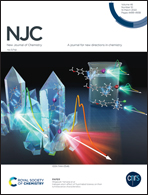Bentonite-titanium dioxide functional nanocomposites suitable for wastewater treatment: an integrated photocatalyst-adsorbent system†
Abstract
An integrated photocatalytic adsorbent system prepared from bentonite clay and titanium dioxide was used for the adsorption/degradation of model organic pollutants and adsorption of heavy metals from industrial wastewater. The functional nanocomposite system containing the photocatalyst and the adsorbent was synthesized via a sol–gel method followed by determining the physicochemical and morphological characteristics using XRD analysis, FTIR analysis, thermal analysis, SEM analysis, and nitrogen sorption analysis. The results obtained confirmed the successful formation of bentonite-titania nanocomposites. The effect of various parameters influencing the functional features of the developed material such as catalyst concentration, pH/temperature of the reaction, etc. was systematically investigated. The enhanced photocatalytic/adsorptive removal efficiencies of the synthesized nanocomposites are attributed to the smaller particle size (∼30–40 nm) and high surface area of the titania particles which enhanced the number of surface-active sites responsible for the degradation of model organic pollutants within a reasonable time. Moreover, the functional nanocomposite was suitable for the removal of heavy metals from model water/industrial wastewater due to its adsorption characteristics. Thus, the methodology adopted in the present work for the synthesis of low cost, recyclable bentonite-titania nanocomposites is a facile and eco-friendly method for wastewater treatment due to the synergistic effect of photocatalysis and adsorption.



 Please wait while we load your content...
Please wait while we load your content...